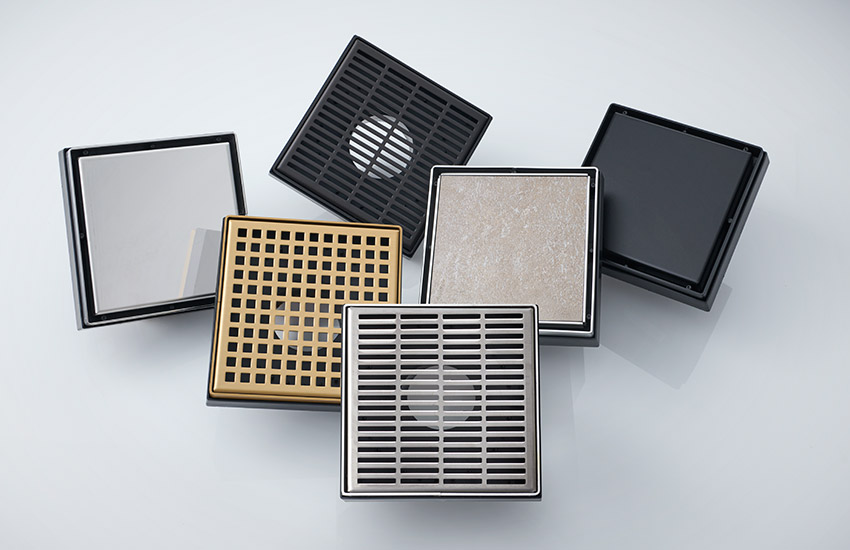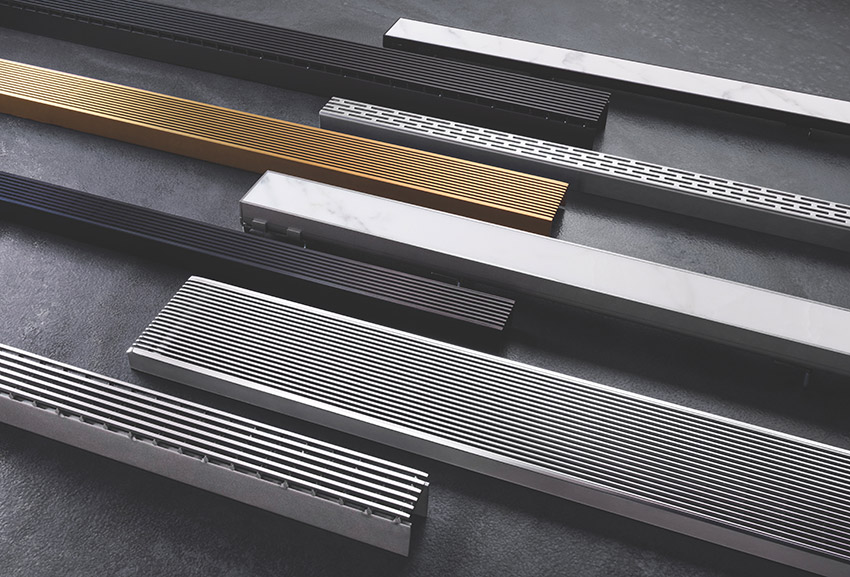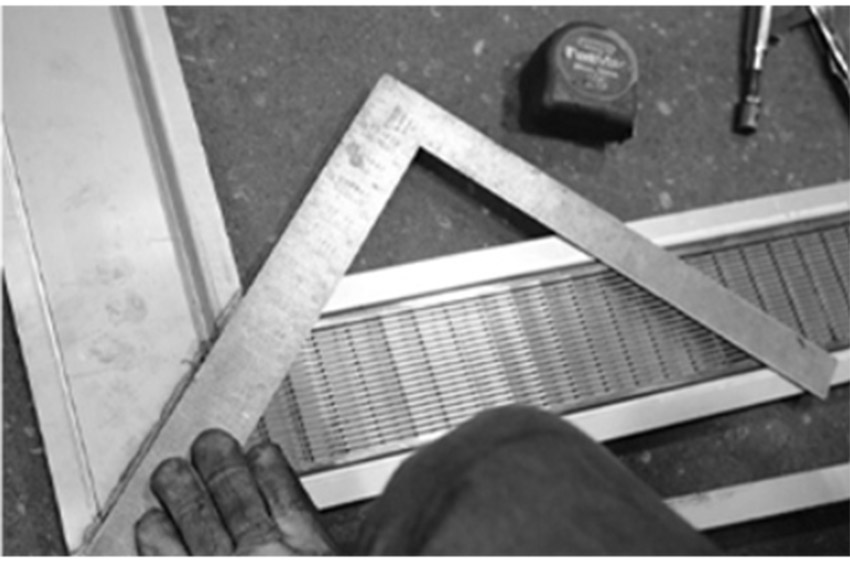Universal Design Incorporating Architectural Linear Drains
UNIVERSAL DESIGN AND DRAINAGE SYSTEMS
As seen in the preceding sections, Universal Design is applicable to virtually all areas in a building where people move, work, or function. Rather than try to address all the possible scenarios or situations, in this course, we will focus on one aspect as an example of Universal Design thinking that can be replicated and applied to other areas. Specifically, we turn our attention now to a common feature in most buildings that require design coordination between architects and plumbing engineers, namely, in-floor drainage systems. Such systems are necessary to provide long-term removal of water from places like restrooms, balconies, terraces, or any other walking surfaces that are exposed to rainwater or the potential for water on the floor from plumbing systems. In these cases, the safety of those walking on the surface is paramount to prevent slip-and-fall accidents or injuries. In terms of Universal Design, the means for creating safe drainage must not impede the ability of anyone to walk on or over the drainage system. That suggests that systems need to be recessed into the floor, terrace, balcony, swimming pool area, etc. such that the top of the visible drainage elements are flush with the surrounding surface. This prevents any tripping hazard, but also allows for smooth travel by anyone whether by walking, using a walking aid (i.e., walker, cane, crutches, etc.), or a wheelchair.
There are other specific cases where drainage systems and Universal Design come into play, such as shower stalls, whether as part of a bathroom, locker room, or even an outdoor swimming pool area. In these cases, the same design criteria apply in that everyone should be able to access the shower without it appearing to be different or separate for those with any disabilities —all the shower stalls should be attractive and functional. The use of drainage systems that blend and are essentially flush with the surrounding surfaces will provide easy access while often contributing to the general design concept for the space where the showers are located. It is common to see accessible shower stalls that use linear drains to capture the drainage water while allowing a wheelchair to enter smoothly into the shower area—the floor is simply sloped slightly (commonly ¼-inch rise per 12 inches) to direct the water to the drain and still allow for wheelchair access.
There are also utility areas in buildings where water drainage is needed to meet practical or code concerns, such as mechanical equipment rooms or elevator rooms which have some newly issued code requirements for drainage. While it is easy to think of these as places only for equipment, the reality is that people need to access them for operations, maintenance, and other ongoing needs. While such places aren’t usually required to be addressed for wheelchair accessibility, they can still benefit from Universal Design principles by making them easy to access without any safety hazards for the people who do work there. That means appropriate attention to the design of the floor drainage systems can alleviate safety hazards, make the system easier to maintain, and provide effective water drainage.
Overall, applying Universal Design principles to floor drainage means that the portion of the system that is visible should be able to blend in to be flush and match the surrounding design. That is not only good for easy passage but is also often what most designers prefer. Keep in mind though, that what is seen above the floor can be part of a wanted design, but what is really needed is the part below the floor. That’s where some basic plumbing engineering and proper product selection come into play to be sure that the appropriate capacity and details for drainage are addressed so the whole system performs as intended. Ultimately, a floor drain system ties into the larger building plumbing waste line system and needs to be coordinated accordingly.
There are, of course, some performance aspects of the visible portion of the drains as well. These include the ability of a grate or cover to meet barrier-free accessibility requirements for the surface and minimization of height (i.e., less than ½ inch above surrounding floor). But such surfaces also need to be safe for walking people too, such that any openings don’t allow for walking canes or high heels to get caught or stuck causing a fall. The surface needs to be readily maintained and cleaned for purposes of proper functioning and hygiene. Systems that are integrated minimize the use of grout and have durable, easy-to-clean exposed surfaces will be best in most cases.
Drainage Types
Not all drainage solutions are the same. Some require very standard components and others are better served by specialty items. Generically, there are three types of drains, discussed as follows.
- Center Drains These are probably what most people think of when considering the use of a floor drain. In this case, a floor area, whether for a room, a shower, or an outdoor surface, is gently sloped from each side to a low point in the center. The drain catchment, commonly square or round, is connected to a suitably sized drainpipe that carries the collected water away from the area to its appropriate next destination (i.e., sewer, storm drain, retention pond, etc.). The catchment mechanism is typically covered with a grate or grille of some type that allows water to enter but keeps out other things such as debris. The cover also provides the needed safety protection for people such that their foot lands on a smooth, flat surface instead of dropping into the open area of the catchment. The shape of a center drain is commonly square or round and available in standard sizes to suit different common conditions.
- Architectural Linear Drains A different, and often more elegant, approach for designing a floor drain is to simply slope the surface all to one side. Then, along the length of the low end of the surface, a linear floor drain is installed in a recessed manner to drain away the water. In this case, the drain catchment area (also called a channel assembly) is long and rectangular with either a vertical or horizontal drain outlet. That drain outlet can be connected in an appropriate manner to suitable drain piping that is located within the floor assembly or outdoor surface system. The drain channel assembly is covered with a long, rectangular grille or grate that functions the same way the center drain cover does, allowing water to enter while keeping out debris and providing a safe surface for people to walk on.
- Custom Drain Solutions In some cases, neither center drains nor purely linear drains are the right architectural solution for a project condition. For those situations, it is good to be aware that custom drains are indeed possible. They can take the form of curved or circular drains around a similarly shaped surface where water needs to be captured and redirected. Or they can be rectilinear by marrying several linear drains together to suit the geometry of a space. There are many different options and configurations possible, but as with any custom solution, it is best to check with a manufacturer during project design to determine fabrication parameters and tolerances that are possible and factors that influence cost management. For example, a custom drain can address unique performance requirements, such as the percent of open or free area of the top grate or a larger outlet diameter that may be required in geographic areas that receive higher levels of precipitation. Custom drain grates can also be designed to address certain load requirements that may be in place for outdoor drains such as heavy cleaning or maintenance equipment around a pool.

Photo courtesy of Infinity Drain
Center drains are based on sloping the surrounding floor or other surface to a central point that receives water into a catchment with a protective cover.

Photo courtesy of Infinity Drain
Architectural linear drains provide an elegant drainage solution based on sloping the floor surface to one side and removing water along the low end.

Photo courtesy of Infinity Drain
Custom drain solutions can take many forms and shapes subject to review with a manufacturer.
Drain Covers
Regardless of the type of drain selected, the visible part of the architectural drainage system is the cover. This is the component that will play prominently in the ability to meet Universal Design needs. Typically, these are metal grates most often fabricated from different types of stainless steel. The thickness of the steel can vary from 18 gauge down to 7 gauge to suit different project weight-bearing conditions. The final appearance can vary based on the selection of the pattern of openings, which include linear grille (wedge wire), perforated holes, and others, and the final color of the finished metal—there are numerous options for both. In this way, the drain grate can either blend into the floor surface to be less noticeable or be used to create a contrasting line that works toward a purpose in the overall design.
If the desire is to have the cover blend into the surrounding surface and visually disappear, then there are also options to have a linear opening on either side of a central section that is designed to receive finishing material or tile that matches the surroundings. In this way, the linear drain takes on the same appearance as the surrounding floor or outdoor surface. If complete obscurity is sought, then there is also the option of using a recessed reveal slot drain such that the flooring extends over the flange of the channel and allows the water to enter the channel via a 3/8-inch reveal in the surface of the floor. A small removable clean-out panel allows the channel and drain line to be accessed in this case. Because of these different approaches, it is easy to see why architectural drains offer an elegant and coordinated look for architects and designers to create well-designed, elegant spaces without the visual interruption of the grates or covers.
With a better understanding of drainage systems and their relationship to Universal Design, we turn our attention next to specific building types with examples of projects that incorporate the principles discussed and some design solutions that have been implemented.









